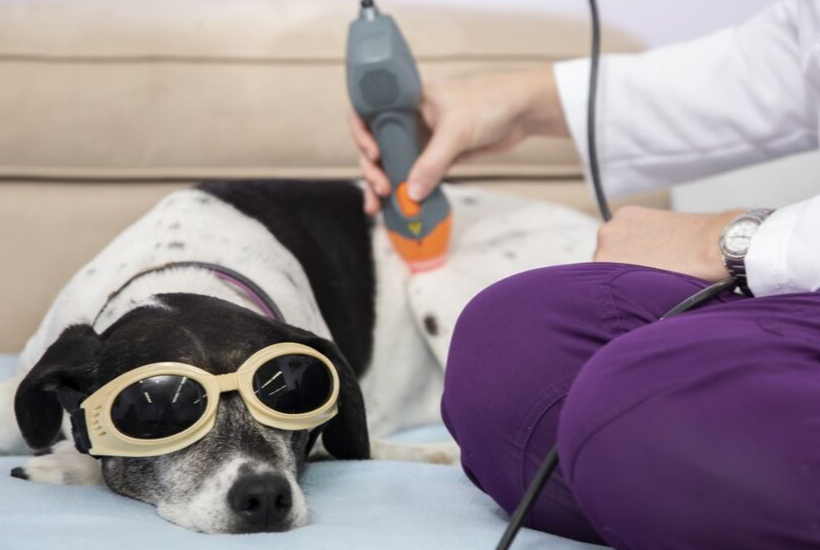Dogs, like humans, can suffer from chronic pain, arthritis, inflammation, and injuries that affect their quality of life. One modern and increasingly popular method of managing pain and promoting healing in dogs is laser therapy. Also known as cold laser therapy or low-level laser therapy (LLLT), this non-invasive treatment is revolutionizing veterinary care. Whether your dog is recovering from surgery or dealing with age-related joint issues, laser therapy can offer a safe and effective solution.
Here are the top 10 benefits of dog laser therapy:
1. Pain Relief Without Medication
Laser therapy is widely used for its pain-relieving properties. The laser emits light energy that penetrates tissues, reduces nerve sensitivity, and triggers the release of endorphins — the body’s natural painkillers. This offers relief from chronic and acute pain without the side effects of drugs.
2. Reduces Inflammation and Swelling
Laser therapy promotes vasodilation (expansion of blood vessels), which improves blood circulation and reduces fluid buildup. This helps control inflammation and swelling, especially in joints affected by arthritis or injuries.
3. Accelerates Healing
By stimulating cell regeneration and increasing metabolic activity, laser therapy speeds up tissue repair. This makes it ideal for post-operative recovery, wound healing, and treating injuries like ligament tears and sprains.
4. Improves Joint Mobility
Dogs with arthritis or joint degeneration often suffer from stiffness and decreased range of motion. Laser therapy can soften tissues and relax muscles, helping restore movement and flexibility in aging or injured dogs.
5. Non-Invasive and Painless
One of the biggest advantages of laser therapy is that it’s completely non-invasive and painless. There are no incisions, no anesthesia, and no discomfort during or after the treatment. Most dogs find it soothing and even relaxing.
6. Reduces the Need for Medications
Because laser therapy manages pain and inflammation effectively, it can reduce your dog’s dependence on long-term medications like NSAIDs or steroids, which often have harmful side effects with extended use.
7. Supports Post-Surgical Recovery
Veterinarians often recommend laser therapy after surgeries to accelerate healing, minimize scar tissue, and reduce post-operative discomfort. It helps dogs recover faster and get back to their normal activity levels.
8. Helps Treat Chronic Conditions
Laser therapy is highly effective in managing chronic issues such as:
- Osteoarthritis
- Hip dysplasia
- Intervertebral disc disease (IVDD)
- Degenerative joint disease
- Lick granulomas
It offers ongoing relief and improves your dog’s long-term comfort and mobility.
9. Safe for All Dog Breeds and Ages
Whether you have a young pup with an injury or a senior dog with arthritis, laser therapy is safe for all ages and breeds. It’s gentle enough for older dogs with multiple health conditions and effective enough for athletic dogs recovering from trauma.
10. No Downtime Required
After a laser therapy session, your dog can go about its normal day. Unlike surgery or more invasive treatments, there’s no recovery period, so your dog can walk, play, or rest immediately after the session.
Frequently Asked Questions (FAQs)
Q1. What conditions can dog laser therapy treat?
Laser therapy is commonly used to treat:
- Arthritis and joint pain
- Muscle strains or sprains
- Post-surgical recovery
- Hip dysplasia
- Spinal issues
- Open wounds and ulcers
- Ear infections
- Inflammatory bowel disease
- Lick granulomas
- Tendon and ligament injuries
Q2. How long does a session last?
A typical dog laser therapy session lasts between 5 to 20 minutes, depending on the size of the dog and the area being treated.
Q3. How many sessions will my dog need?
The number of sessions varies based on the condition being treated. Acute injuries may only need a few sessions, while chronic conditions like arthritis may require ongoing treatments 1-2 times a week initially, followed by maintenance sessions every few weeks.
Q4. Is laser therapy safe for dogs?
Yes, laser therapy is FDA-approved and considered very safe for dogs when performed by trained professionals. There are no known side effects when used appropriately.
Q5. Does laser therapy hurt my dog?
No, laser therapy is painless. Most dogs feel a warm, soothing sensation during the treatment and often relax or fall asleep during sessions.
Q6. Can laser therapy be combined with other treatments?
Absolutely! Laser therapy is often part of a comprehensive treatment plan, which may include physical therapy, medications, or supplements. It complements other therapies by enhancing healing and reducing pain.
Q7. Are results immediate?
Some dogs show improvement after just one session, while others may need several sessions to see noticeable changes. Chronic conditions generally require more time for visible results.
Q8. How much does dog laser therapy cost?
The cost can vary depending on the clinic and condition being treated but generally ranges from $30 to $100 per session in the US. Many clinics offer package deals for long-term treatments.
Q9. Are there any dogs that shouldn’t get laser therapy?
Laser therapy may be avoided in dogs with certain types of cancer, as increased blood flow could stimulate tumor growth. Your vet will assess your dog’s overall health before recommending laser therapy.
Q10. Where can I get laser therapy for my dog?
Laser therapy is offered at many veterinary clinics, specialty animal hospitals, and rehabilitation centers. Always ensure the practitioner is experienced in canine laser therapy.
Conclusion
Dog laser therapy is a game-changer in veterinary medicine, offering a drug-free, non-invasive, and effective solution for managing pain and promoting healing. Whether your dog is young, aging, recovering from surgery, or battling chronic pain, laser therapy can provide noticeable improvements in their mobility, comfort, and overall quality of life.
As always, consult your veterinarian to determine whether laser therapy is the right choice for your furry friend. With the right treatment plan, your dog can live a happier, more active life — pain-free!

